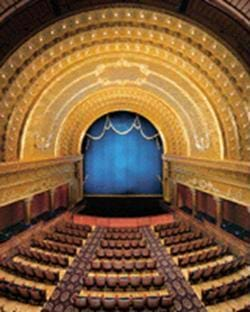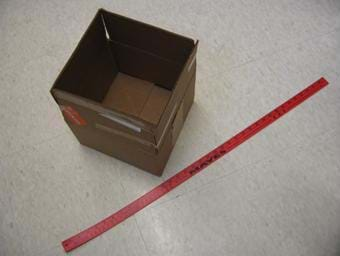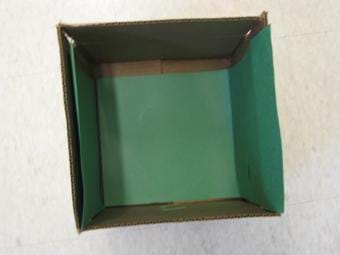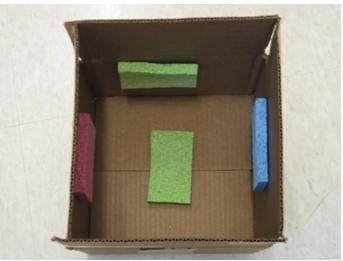Quick Look
Grade Level: 4 (3-5)
Time Required: 45 minutes
Expendable Cost/Group: US $2.00
Group Size: 2
Activity Dependency:
Subject Areas: Science and Technology
NGSS Performance Expectations:

| 3-5-ETS1-1 |
| 3-5-ETS1-3 |

Summary
Students model and design the sound environment for a room. They analyze the sound performance of different materials that represent wallpaper, thick curtains, and sound-absorbing panels. Then, referring to the results of their analysis, they design another room based on certain specifications, and test their designs.Engineering Connection
Acoustical engineering is a specialized branch of engineering having do do with sound, or acoustics. Acoustic engineers design the sound environments for a variety of locations — inside and outside of buildings, as well as other locations where sound is an important issue (for example, along a highway in an urban area).
Learning Objectives
After this activity, students should be able to:
- Analyze different materials representative of ones used in acoustic design.
- Explain that different materials have different sound properties.
- Model a sound environment for a room based on provided specifications.
Educational Standards
Each TeachEngineering lesson or activity is correlated to one or more K-12 science,
technology, engineering or math (STEM) educational standards.
All 100,000+ K-12 STEM standards covered in TeachEngineering are collected, maintained and packaged by the Achievement Standards Network (ASN),
a project of D2L (www.achievementstandards.org).
In the ASN, standards are hierarchically structured: first by source; e.g., by state; within source by type; e.g., science or mathematics;
within type by subtype, then by grade, etc.
Each TeachEngineering lesson or activity is correlated to one or more K-12 science, technology, engineering or math (STEM) educational standards.
All 100,000+ K-12 STEM standards covered in TeachEngineering are collected, maintained and packaged by the Achievement Standards Network (ASN), a project of D2L (www.achievementstandards.org).
In the ASN, standards are hierarchically structured: first by source; e.g., by state; within source by type; e.g., science or mathematics; within type by subtype, then by grade, etc.
NGSS: Next Generation Science Standards - Science
| NGSS Performance Expectation | ||
|---|---|---|
|
3-5-ETS1-1. Define a simple design problem reflecting a need or a want that includes specified criteria for success and constraints on materials, time, or cost. (Grades 3 - 5) Do you agree with this alignment? |
||
| Click to view other curriculum aligned to this Performance Expectation | ||
| This activity focuses on the following Three Dimensional Learning aspects of NGSS: | ||
| Science & Engineering Practices | Disciplinary Core Ideas | Crosscutting Concepts |
| Define a simple design problem that can be solved through the development of an object, tool, process, or system and includes several criteria for success and constraints on materials, time, or cost. Alignment agreement: | Possible solutions to a problem are limited by available materials and resources (constraints). The success of a designed solution is determined by considering the desired features of a solution (criteria). Different proposals for solutions can be compared on the basis of how well each one meets the specified criteria for success or how well each takes the constraints into account. Alignment agreement: | People's needs and wants change over time, as do their demands for new and improved technologies. Alignment agreement: |
| NGSS Performance Expectation | ||
|---|---|---|
|
3-5-ETS1-3. Plan and carry out fair tests in which variables are controlled and failure points are considered to identify aspects of a model or prototype that can be improved. (Grades 3 - 5) Do you agree with this alignment? |
||
| Click to view other curriculum aligned to this Performance Expectation | ||
| This activity focuses on the following Three Dimensional Learning aspects of NGSS: | ||
| Science & Engineering Practices | Disciplinary Core Ideas | Crosscutting Concepts |
| Plan and conduct an investigation collaboratively to produce data to serve as the basis for evidence, using fair tests in which variables are controlled and the number of trials considered. Alignment agreement: | Tests are often designed to identify failure points or difficulties, which suggest the elements of the design that need to be improved. Alignment agreement: Different solutions need to be tested in order to determine which of them best solves the problem, given the criteria and the constraints.Alignment agreement: | |
International Technology and Engineering Educators Association - Technology
-
Models are used to communicate and test design ideas and processes.
(Grades
3 -
5)
More Details
Do you agree with this alignment?
-
Identify and collect information about everyday problems that can be solved by technology, and generate ideas and requirements for solving a problem.
(Grades
3 -
5)
More Details
Do you agree with this alignment?
Materials List
Each group needs:
- 1 cardboard box of at least 1 foot square (with an open side, see Figure 1)

- 4 cello sponges, 2x4 in.
- several sheets of any color construction paper
- several sheets of felt cloth, approximately 8 x 10 each
- 1 pair of scissors
To share with the entire class:
- duct tape
- clear (cellophane or transparent) tape
- variety of multi-colored markers
- 15-30 sheets of plain white paper (can use recycled)
Pre-Req Knowledge
Students should be familiar with sound being described in terms of quality and volume. This activity works well accompanying a science unit on sound or waves.
Introduction/Motivation
Is there a difference in the volume of sound in this classroom versus the cafeteria? How is the sound different? (Answer: The cafeteria is louder.) What about the quality of sound? Is it easier to understand someone talking in the classroom or the cafeteria? Let's make a list of some of the physical differences between the cafeteria and this classroom. Everyone take a minute to think and write.
What were some of the things you listed? (Possible answers: The classroom has carpet, the cafeteria does not; the cafeteria is much larger than this classroom; this classroom has ceiling tiles, the cafeteria might not.) Now I want you to tell the person sitting next to you how these physical differences affect the sound differences between these two rooms. Please take one minute to do this.
What did you discuss with your partner? What affect did the physical differences have? (Possible answers: Carpet and ceiling tiles absorb sound waves, producing few echoes and an overall quieter environment. Hard surfaces reflect waves, causing more echoes and making it difficult to hear someone speaking.)
Today we are going to analyze several different materials to see how they affect the sound in a room. Like engineers, we are going to make a model called a prototype. Each material we analyze represents a material that is used in building designs by acoustical engineers for changing sound quality. We are going to listen and see how sound is affected by each of the materials. Then we are going to use what we learned to create our own design for a new room, just like acoustical engineers.
Procedure
Before the Activity
- Gather materials.
- If asking students to collect their own boxes, give the assignment one week in advance; remind students regularly. Collect extra boxes for those students who forget.
With the Students
Give students the following instructions before handing out materials.
Introduction
Think of this box as a room with three walls, with one open wall (the area in which you will speak), a ceiling and a floor. We are going to use this prototype, or small model, to help us understand how different materials affect sound. Each material that we are using represents a similar material that is used in actual room design by acoustical engineers.
Empty Room
- One partner takes the box and speaks into it, while the other partner stands at the other (closed) end of the box. In a regular (inside) voice, say "Hello" to your partner and "How are you doing?"
- Both partners should listen carefully.
- Now let the other partner speak into the box.
- Both partners listen again.
Wall Paper in Room
- Use clear tape to apply construction paper to the three walls of the room, representing wall paper, as shown in Figure 2.

- Both partners take a turn speaking into box.
- Each partner should listen each time.
- Compare the sound quality and volume to when there was no construction paper.
- Carefully remove paper from walls.
- Refresh your memory of the sound of the empty room.
Sound Curtains
- Duct tape felt cloth to the three walls to represent sound curtains (as shown in Figure 3).

- Repeat the talking and listening procedure described above.
- Do curtains make a larger difference in the noise level? Compare the sound quality and volume to when there was no felt curtains.
- Carefully remove curtains.
- Refresh your memory of the sound of the empty room.
Sound Absorbing Panels
- Use duct tape to fasten sponges to the walls and the ceiling, representing sound-absorbing panels (see Figure 4).

- Again repeat the talking and listening procedure, used in the previous experiments.
- How do the sound absorbing panels compare? Compare the sound quality and volume to to when there were no absorbing panels.
- Carefully remove sponges.
- Refresh memory of the sound of the empty room.
Room Design
- You have been hired by "Form vs. Function," an architectural firm that is designing a building with one of the following rooms in it. They would like you to help them design a room to meet the required sound specifications.
Based on your observations of the different materials, design the sound environment for the room requested by the architectural firm. You may use any or all three of the materials you tested or come up with your own ideas for materials to use. (Note: The teacher may choose one room for the students to design or assign each team a different room.)
Engineering specifications:
- The building has a movie theater in it. Design a sound environment for pleasant sound quality, loud sound volume, and comfortable for the audience to hear at any place in the theater.
- The building has a basketball arena in it. Design a sound environment for loud sound volume, where the sounds of cheering will be heard by the teams, and comfortable for the fans to see the game.
- The building has a music recording studio in it. Design a quiet sound environment to reduce echoes, where the musicians can hear each other clearly, and there is no extra noise in the room that can be picked up by microphones.
- As a class, define the problem that you are working on, including the specifications. (Note: Inform the students that this is one of the first steps in an engineering design. It also helps students understand the task.) The problem statement might start with, "Design a sound environment that is..."
- Test your ideas with the empty box the same way that you tested the individual materials earlier.
- Draw a design of your final room on a blank piece of paper, label the materials that you used, where they were placed and where the people will be. You may use markers to help with your design.
- Conduct the drawing post-assessment actvity as described in the Assessment section.
Vocabulary/Definitions
acoustics: The study of sound; the characteristics of sound in an environment.
echo: To hear something again due to the reflection of a sound wave.
prototype: A smaller model of something that is being designed or tested.
sound quality: A description of how clear or pleasing a sound is.
sound volume: A description of how loud a sound is.
Assessment
Pre-Activity Assessment
Discussion: As a class, have students engage in open discussion. Solicit, integrate and summarize student responses. Remind them that in brainstorming, no idea or suggestion is "silly." All ideas should be respectfully heard. Take an uncritical position, encourage wild ideas and discourage criticism of ideas. Have them raise their hands to respond. Ask the students:
- Is there a difference in the volume of sound in this classroom compared to the cafeteria?
- What about the quality of sound?
Activity Embedded Assessment
Prediction Poll: Before passing out materials, ask all students the same question. Have students raise their hand to provide their hypothesis/prediction. Write answers on the board, and summarize (in percentages or actual count) who answered similarly. Ask students:
- What material do you think will absorb the most sound?
Post-Activity Assessment
Drawing: Have students depict the sound waves in their box for each material. They may elect to simply draw one wall and show how the sound waves are either absorbed or reflected. Note that fewer sound waves should reflect from fabric curtains than wallpaper and that the sound panels will not absorb sound waves that strike the wall around them.
Engineering Impacts: Have students discuss how the acoustical design of rooms affects the people in that room. How has acoustical engineering helped people? Why are there different sound environments for different types of rooms? Ask student to think of any experiences they have had in which the sound environment or acoustical design did not match the purpose of the room.
Presentations: Have students model their final designs in the box, and present their designs to the class. They may use extra construction paper and markers to decorate the rooms as if people were inside.
Activity Extensions
Acoustical engineering is often used in industrial buildings. Ask students to think about why industries and factories might need acoustical engineering to create different sound environments.
Have students develop sound environments for another type of room or urban area of their choosing. Have them consider design for sound environments around airports or busy highways.
Invite an acoustical engineer to give a presentation to the class.
Subscribe
Get the inside scoop on all things TeachEngineering such as new site features, curriculum updates, video releases, and more by signing up for our newsletter!More Curriculum Like This

Students learn how different materials reflect and absorb sound.

Students are introduced to the sound environment as an important aspect of a room or building. Several examples of acoustical engineering design for varied environments are presented.

Students explore how sound waves move through liquids, solids and gases in a series of simple sound energy experiments.
References
Ohio Cultural Facilities Commission, Cultural Projects, "Southern Theatre," accessed July 24, 2008. http://www.culture.ohio.gov/commission/detail.asp?id=674
Copyright
© 2008 by Regents of the University of Colorado.Contributors
Michael Bendewald; Malinda Schaefer Zarske; Janet YowellSupporting Program
Integrated Teaching and Learning Program, College of Engineering, University of Colorado BoulderAcknowledgements
The contents of this digital library curriculum were developed under a grant from the Fund for the Improvement of Postsecondary Education (FIPSE), U.S. Department of Education, and National Science Foundation GK-12 grant no 0338326. However, these contents do not necessarily represent the policies of the Department of Education or National Science Foundation, and you should not assume endorsement by the federal government.
Last modified: May 10, 2019









User Comments & Tips